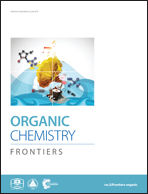Regioselective Zn(OAc)2-catalyzed azide–alkyne cycloaddition in water: the green click-chemistry†
Abstract
A new method of azide–alkyne cycloaddition (AAC) in the presence of Zn(OAc)2 as an inexpensive and environmentally friendly catalyst in neat water has been developed. The proposed methodology has been applied for the synthesis of 1,4-disubstituted-1,2,3-triazoles from terminal alkynes and 1,4,5-trisubstituted-1,2,3-triazoles from internal alkynes. It has been found that Zn-catalyzed AAC is extremely sensitive to steric hindrance in acetylenes and a method of regioselective triazole ring formation has been proposed. Particularly important is the isolation and characterization of a relatively stable Zn-containing intermediate, which has been characterized by NMR and HRMS.



 Please wait while we load your content...
Please wait while we load your content...